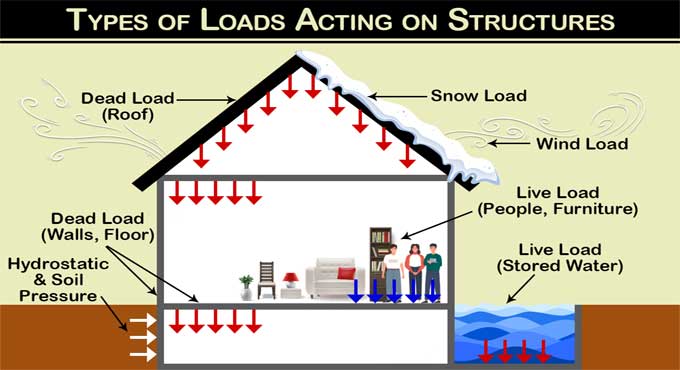
Various types of loads on a structure

Structures are exposed to loads, which are applied forces, deformations, or accelerations. A load results in the strain, deformation, and displacement of a structure. An engineering subject known as structural analysis makes an effort to predict how loads will impact structures and structural parts.
When designing a structure, an excess load should be taken into account and regulated as it may result in structural failure.
A structure may experience stress, displacement, and deformation from many sorts of loads, which can lead to structural issues or even structural failure. Determining the overall load on a structure is a crucial and complicated process.
Kinds of loads impacting a structure
Safety and economy are two key considerations that are taken into consideration while designing a structure.
The economy is impacted if the loads are appraised and taken higher. Safety is jeopardized if loads are carried at a lower rate for the sake of the economy. Therefore, it is necessary to compute accurately the estimation of various active loads.
Dead loads in a structure
The weight of a building's structural parts, such as beams, walls, roofs, and structural flooring components, is an example of a dead load, also known as a permanent load or a static load. Non-structural permanent dividers, immovable fixtures, and even built-in cabinets are examples of dead loads.
Before any live loads are taken into account, the structures or other permanent parts' weight is referred to as the dead loads.
The overall loading placed on the structure is calculated by adding the live and dead loads together. The volume of each segment is multiplied by the unit material weight to determine the dead loads of each construction.
Live loads in a structure
Implied loads, also known as living loads, are the second vertical load that must be taken into account while designing a building. Live loads are any moveable or moving objects that are not experiencing acceleration or impact.
These loads which can include the weights of mobile walls or furniture, among other things are considered to be generated by the building's intended usage or occupancy.
One of the main loads in the design is the live load, which is always changing and must be appropriately assumed by the designer.
The floor slabs must be built to support either evenly distributed loads or concentrated loads, depending on which causes more stress on the component under discussion.
Wind loads in a structure
Wind load is mostly a horizontal load brought on by air movement with respect to the earth. In particular, when the height of the structure reaches two times the dimensions transverse to the exposed wind surface, wind load must be taken into account in structural design.
The wind load is not crucial for low-rise structures, i.e. those with four to five stories because the walls placed between columns and the continuous floor system to column connection give enough moment of resistance to withstand the effects of these forces.
Snow loads in a structure
This is the load that can be imposed by the accumulation of snow and is more of a concern in geographic regions where snowfalls can be heavy and frequent.
Significant quantities of snow can accumulate, adding a sizable load to a structure. The shape of a roof is a particularly important factor in the magnitude of the snow load.
Factors to be considered while calculating the snow?s weight:
1. Variations in temperature
2. Contents in atmosphere
3. Load distribution.
Earthquake loads in a structure
Due to the inertia force that seismic excitations induce in the building, earthquake load occurs. With respect to mass, inertia force varies. Because of the structure's increased mass, the earthquake loading is likewise likely to be higher.
The structure will crack or sustain damage when the earthquake load exceeds the moment of resistance provided by the element.
To learn more, watch the following video tutorial.
Video Source: Engineer Boy
The weight or mass of the building, its dynamic characteristics, the variation in stiffness between adjacent levels, the strength and length of the earthquake, as well as other factors, determine the magnitude of earthquake loading.
Buildings in seismically active places must be carefully evaluated and planned to guarantee that they won't collapse if an earthquake happens.


